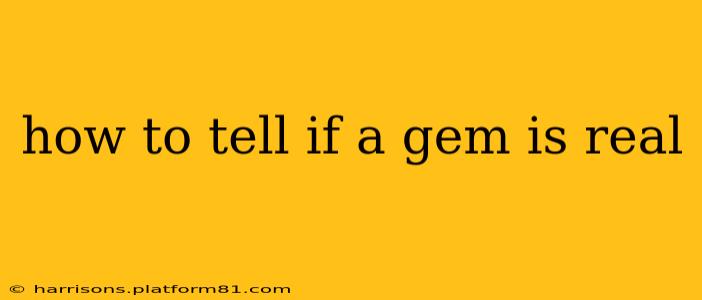Determining the authenticity of a gem can be tricky, especially with the proliferation of skilled imitations and synthetic stones in the market. However, with a little knowledge and the right techniques, you can significantly improve your chances of identifying real gemstones. This guide will walk you through several methods, addressing common questions and concerns.
What are the Different Ways to Test if a Gemstone is Real?
There's no single foolproof test to identify a real gem, but a combination of methods provides the best results. These methods range from simple visual inspections to more advanced techniques requiring specialized tools.
Visual Inspection: The First Line of Defense
The first step in determining a gem's authenticity is a careful visual inspection. Look for:
- Clarity and Inclusions: Real gemstones almost always have natural inclusions – tiny imperfections or flaws within the stone. These are unique fingerprints of natural formation. Perfectly flawless stones are highly suspicious, particularly with rarer gems. Synthetic stones often have consistent and repetitive inclusions, or lack them altogether.
- Color and Luster: Examine the gem's color and how light interacts with it (luster). Real gems often exhibit subtle variations in color and a complex interplay of light and shadow. Artificial stones may have an overly uniform or artificial-looking color.
- Cut and Polish: While the quality of the cut and polish doesn't directly indicate authenticity, extremely poor workmanship can be a red flag. Examine for inconsistencies, chips, or uneven facets.
Simple Tests You Can Do at Home
Several simple tests can help you narrow down the possibilities. However, remember these are not definitive and should be used in conjunction with other methods.
- Hardness Test: Use a simple scratch test (with caution!). Real gemstones generally have higher hardness than glass or a steel knife. Try scratching the gem with a steel object; if it scratches easily, it's likely not a genuine gemstone. Note: This test can damage the gem, so proceed with extreme caution and only on inconspicuous areas.
- Heat Test: Some gemstones react differently to heat. For example, a genuine diamond will remain cool to the touch even after being held for a while, while glass will heat up quickly. Note: This test is not conclusive for all gems.
- Water Test: Drop the gem into a glass of water. Real gems generally sink, while some glass imitations may float. Note: This test is not conclusive and depends on the density of the stone and its size relative to the water.
How Can I Tell if a Diamond is Real?
Diamonds pose a unique challenge due to the prevalence of simulants and synthetic diamonds. Beyond the visual inspection and simple tests mentioned above, the following are more reliable for diamonds:
- Professional Appraisal: The most reliable way to authenticate a diamond is through a professional gemologist or appraiser. They have access to specialized equipment such as refractometers, spectroscopes, and UV lamps, providing accurate identification.
- Diamond Tester: These portable devices measure thermal conductivity. Diamonds conduct heat exceptionally well, which is a key differentiator. Note: While helpful, diamond testers may not detect all imitations.
What are the Differences Between Natural, Synthetic, and Imitation Gems?
- Natural Gems: Formed by geological processes over millions of years. They contain unique inclusions and often exhibit subtle variations in color and clarity.
- Synthetic Gems: Grown in laboratories, mimicking the chemical and physical properties of natural gems. While technically not "natural," they can possess excellent quality and are often more affordable.
- Imitation Gems: Made from materials that simply look like gems. They generally have different physical and chemical properties compared to real gemstones and are usually much less durable.
How Much Does it Cost to Get a Gem Authenticated?
The cost of gem authentication varies depending on the gem's type, size, and the appraiser's fee structure. Expect to pay anywhere from a few tens to hundreds of dollars for a professional appraisal.
By combining careful observation, simple tests, and, when necessary, professional appraisal, you can significantly increase your confidence in identifying the authenticity of a gem. Remember that caution and a critical eye are your best allies in the world of gemstones.
